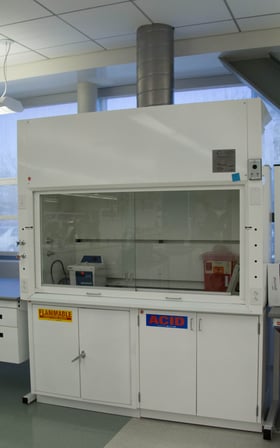A fume hood sash is a glass door located at the front of the fume hood that opens and closes, serving as a doorway to the workstation. The sash is an important safety component, offering protection and containment from dangerous chemicals and other materials.
Successfully using a sash during fume hood operation involves understanding the role of the sash, the type of sash you need for your environment and safety protocols that must be in place.
The Role Of A Fume Hood Sash
 Fume hoods are designed to limit a person from exposure to hazardous fumes, vapors or dust. They are essentially an enclosed industrial workbench with a built-in exhaust system, and feature three enclosed sides with a fourth side open for a worker to operate.
Fume hoods are designed to limit a person from exposure to hazardous fumes, vapors or dust. They are essentially an enclosed industrial workbench with a built-in exhaust system, and feature three enclosed sides with a fourth side open for a worker to operate.
Fume hoods have a fan that creates a positive air flow to pull contaminants to the filtration system. There are two types of fume hoods … ducted and ductless … and in both, the sash plays a critical role in worker safety.
- Ducted fume hoods feature ductwork that is attached to the building. This is why they are stationary and have a fixed location in the lab.
- Ductless fume hoods operate off a carbon filter system that recirculates filtered air into the building. They are ideal for buildings where ductwork is inaccessible or where mobility is necessary.
Although facilities that have ductless fume hoods typically use only a few chemicals in them, the sash is nonetheless important. That’s because a fume hood sash acts as a shield. If a fire occurs, for example, the sash will contain the fire and keep it from spreading.
The sash also helps control how the air moves through the fume hood by pushing harmful vapors and fumes toward the built-in exhaust system.
Types Of Fume Hood Sashes
While fume hood sashes slide open and closed, the direction by which they do so can vary. There are typically three types of sashes:
- Vertical, which slide up and down
- Horizontal, which slide left to right
- A combination of vertical and horizontal
Vertical sashes are common in laboratory and manufacturing because they offer the greatest access to the interior of the hood. Horizontal sashes offer access to the top of the hood, but do not allow a user to easily access to both ends of the hood at the same time.
Although glass is used to construct the fume hood sash, there are several different types of glass that can be used. All are designed to absorb an explosion or fire.
Tempered Glass
When tempered glass breaks, it shatters into tiny pieces with blunt corners. It can withstand radical changes in temperature up to 392 degrees F. Compared to ordinary glass, tempered glass can withstand an impact nearly five times as strong. This makes tempered glass a popular choice for fume hood sashes.
Applications in which higher thermal resistivity is required would typically need tempered glass as the fume hood sash material. For example, tempered glass would likely be the better material if there is a routine use of equipment that emits heat or a drying oven. If there is a risk of a fire in the fume hood, tempered glass would also offer greater protection.
Laminated Glass
Laminated glass is made using two pieces of float glass. In between these two layers is a layer of polyvinyl butyral (PVB). When an explosion occurs, this sandwich approach allows the broken glass pieces to stick to the PVB layer inside, rather than falling to the ground or flying through the air.
Applications in which there is a risk for an explosion would benefit the most from laminated glass since the glass will not shatter if an explosion occurs within the hood. However, it’s important to note that tempered glass can be laminated as well, offering a higher level of protection that combines the best of both options.
Polycarbonate
If your laboratory regularly works with hydrofluoric acid, you may need a polycarbonate glass sash. Because hydrofluoric acid can damage standard glass over time, you may need to replace your sash more often. However, a polycarbonate sash is designed to protect the glass from this type of acid and give your fume hood sash a longer lifespan.
Typical applications that would use polycarbonate glass are ones in which hydrofluoric acid use is common, such as research laboratories, geology labs and facilities that perform semiconductor work.
Fume Hood Sash Safety
 The sash plays an important role in ensuring the overall safety of users when operating the fume hood. However, if fume hood sash safety protocols are not followed, the sash may not operate as intended.
The sash plays an important role in ensuring the overall safety of users when operating the fume hood. However, if fume hood sash safety protocols are not followed, the sash may not operate as intended.
Below are some important safety procedures to implement when using the fume hood sash:
- Always make sure that the sash is open to the appropriate height and/or width indicated for use. This information is usually indicated by locating the arrows on the frame.
- Never open the sash all the way unless you are placing materials inside the unit.
- In the case of vertical rising sashes, users should keep the sash below their face. For sashes that move side to side, keep the sash in front of you and reach around the side of the sash.
- Never place your head inside the opening created by sliding the sash open.
- Keep materials away from the opening of the sash.
- Do not keep chemicals stored inside the hood.
It is important to have protocols put in place so that employees know to report any fume hood issues to a supervisor. If the fume hood is not properly functioning, an employee should close the sash and take the hood out of service.
Our article, Fume Hood Safety Steps To Take In The Event Of An Accident, further outlines what you should do if an accident occurs.
A Critical Component
Though it may seem like a simple piece of glass, the fume hood sash is anything but ordinary.
While the fume hood itself plays an important role in keeping dangerous vapors, fumes and particles from escaping the work area, the sash allows access to the hood while protecting users from devastating injuries in the event that an accident occurs.
When used properly, the fume hood sash is a critical component of the fume hood, ensuring the safety of workers in any laboratory.


